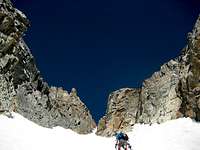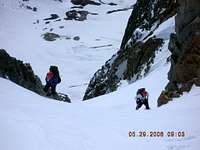-
 21420 Hits
21420 Hits
-
 74.01% Score
74.01% Score
-
 4 Votes
4 Votes
|
|
Route |
|---|---|
|
|
37.02270°N / 118.41824°W |
|
|
Mountaineering |
|
|
Spring |
|
|
Most of a day |
|
|
Class 4 |
|
|
Overview
I can’t say that I’m much of a Split Mountain fan, but it’s not because anything above 10,000’. The road to the trailhead in is the worst in the Sierra, the approach starts at 6,500’, the Red Lake trail is hot and grueling, but once you reach about 10k it’s all worth it. Red Lake is beautiful with the Split Mountain summit towering above it. And the St. Jean Couloir is the jewel of the mountain.The St. Jean Couloir was first climbed by Bill St. Jean in December of 1981. It rises steeply some 1,400’ from the Split Mountain Glacier, to the northern shoulder of Split Mountian. While the couloir provides the most efficient route to gain the summit, it presents dangers and widely varied seasonal climbing conditions.
Getting There & Camping
Please see the main Split Mountain page for directions to the trailhead.The Red Lake Trailhead is located about 100 yards north of the parking area. The trail starts at about 6500’ and climbs steeply over 4.3 miles on a generally poor quality trail to just before Red Lake.
While the trail parallels Red Mountain Creek water is hard to access. There is a spring that usually provides a reliable water source, but it is nearer to the end of the trail. As the trail is hot, dry, and in the sun all morning and most of the afternoon, I’d suggest carrying at least two liters of fluids to make it to the spring.
When traveling near the spring the trail can be hard to follow. We had no trouble on the way up, but we lost to trail on descent. If you loose the trail chances are it’s above you. I suggest retracing you path until you find the correct trail. You’ll pay a huge penalty if you decide to try to bushwhack ahead to find the trail (as I did).
After passing a smaller lake the trail fades away to nothing. However, Red Lake is only a short distance away and the route is obvious.
There are plenty of established tent pads in the trees below Red Lake and it’s eastern shore. Campfires are not allowed below 10,400’ and while bear cans are not required, you must store your food and refuse so that animals cannot get to it.
Red Tape
Permits are required year round for overnight trips and quotas apply May 1, through November 1. The daily entry quota for the Red Lake Trailhead is eight. Five permits are reserveable up to six months in advance at a cost of $5 per person. Three are set aside for walk-in use. Walk-in permits must be requested in person and cannot be requested more than one day ahead of the trip.Wilderness Office phone line (760-873-2483) is open 8:00 am to 4:30 pm
During the summer season open every day from May 15 to Oct. 15.
During the winter season (Oct. 16 to May 14) closed on weekends and holidays.
Mail: Wilderness Permit Reservation Office
Inyo National Forest
351 Pacu Lane, Suite 200
Bishop, CA 93514
Phone: (760) 873-2483
Fax: (760) 873-2484
Route Description
Having only climbed the St Jean Couloir under good spring conditions I had to research as much information as I could about climbing conditions during the other seasons. The only thing I can tell you for sure is that the climb varies vastly from season to season and year to year. I thought it was fairly easy and straight forward in May of 2009, yet a much more experienced climber then I called it “Spicy” in May of 2006. Secor says the couloir is 35 to 40 degrees and another climber called it 50 to 70? The truth is probably somewhere in the middle. I’ve tried to condense/consolidate the best information I could find.The St Jean Couloir faces almost directly east. This means it gets full sun first thing in the morning. The sun will soften the snow and give you the opportunity to posthole up the entire climb if you enter too late in the morning. Also the sun will be blazing at your back keeping you warmer than most climbers enjoy. As evidenced by the debris field shown in the video below and a couple of the gallery pictures, rock fall is common in the couloir. As well, the 40 to 50 degree slope of the couloir is ideal for avalanches. For the reasons mentioned above I recommend you enter the couloir as close to sunrise as possible.
From Red Lake the St Jean Couloir should be obvious to the right of Splits central couloir. Travel east on benches, slopes, scree or snow to the Split Mountain Glacier and up then up through the debris/avalanche run-out field to base of the couloir.
The couloir starts by climbing through a narrow 35 to 40 degree passage for the first 300’ feet of gain. While climbing this section you have little to no chance of avoiding avalanches or substantial rock fall. Be ready to go and climb efficiently through this section. After that the couloir opens up some. As you climb further the slope will gradually increase to perhaps 50 degrees just before you top out on the northern shoulder of Split Mountain. From there turn left/south and climb another 300 to 400 feet to the summit.
In the winter/spring expect this to be a straight forward snow climb. Snow conditions will be harder/icier on a cloudy day. And avalanche danger will be high after storms.
In the summer/fall a bergschrund may be encountered at the entrance to the couloir. One climber reported “A very moderate route with a trick(y) schrund crossing when we were there. We did some 5.8ish rock to the right to get by.” In wet years you may find alpine ice with four or five steeper, but short steps of thick water ice covering the 4th class rock. In a dry year you may find the couloir to be a loose class 3/4 scramble with only patches of snow and ice. A climber in August of 2002 noted “Boy, did I pick a bad time of the year to do this route. It looked nice from below but was filled with dirt, loose rock, wet remnants of snow and a patch of ice here and there.”
Depending on conditions, your skill, and fitness level the climb may take from 1.5 to 4 hours.
I can’t recommend descending the St Jean Couloir. I didn’t, and the only account I found of it being used for descent wasn’t pretty. Instead descend the North Slope route back to Red Lake.





